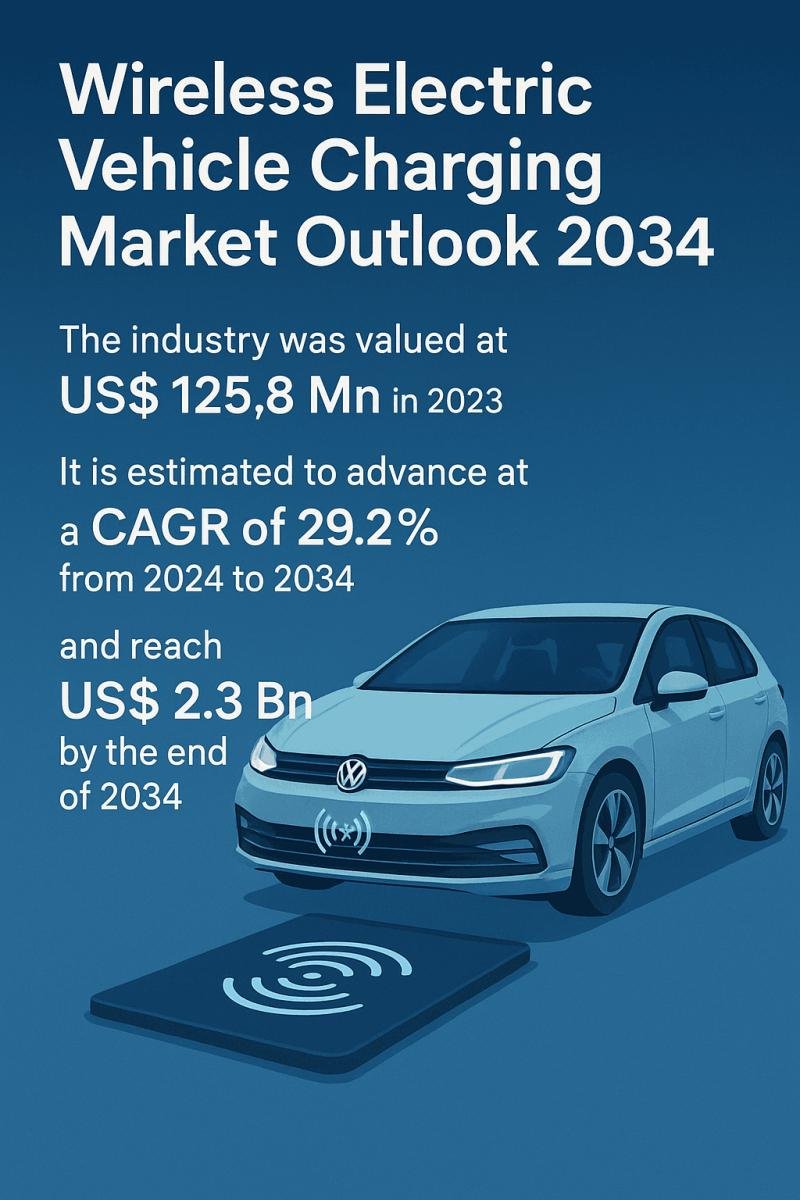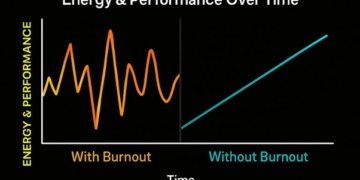Market Overview
The Wireless Electric Vehicle Charging Market was valued at US$ 125.8 Million in 2023 and is expected to surge to US$ 2.3 Billion by 2034, growing at an impressive CAGR of 29.2% from 2024 to 2034. This rapid expansion is driven by increasing adoption of electric vehicles and the demand for convenient, cable-free charging solutions. Technological advancements and supportive government policies are also fueling market growth.
For more insights and to request a sample copy of the market report, visit: https://www.transparencymarketresearch.com/sample/sample.php?flag=S&rep_id=70872
The Wireless Electric Vehicle (EV) Charging Market is experiencing transformative growth, driven by the increasing adoption of electric vehicles, advancements in charging technologies, and a global push towards sustainable transportation solutions. Wireless charging, also known as inductive charging, eliminates the need for physical connectors by transferring energy through electromagnetic fields between a charging pad on the ground and a receiver on the vehicle.
Analyst Viewpoint
Industry analysts highlight several key factors contributing to the market’s expansion:
• Technological Advancements: Innovations in inductive charging technology have enhanced power transfer efficiency, allowing for faster charging times comparable to traditional plug-in methods.
• Government Support: Policies and incentives aimed at promoting electric vehicle adoption and infrastructure development are accelerating the deployment of wireless charging stations.
• Consumer Demand: The convenience of wireless charging appeals to EV owners, reducing the hassle of physical connectors and simplifying the charging process.
• Integration with Smart Technologies: The integration of wireless charging with smart grids and Vehicle-to-Grid (V2G) systems enables bidirectional energy flow, enhancing grid stability and making EVs an integral part of the energy ecosystem.
Key Player Analysis in the Wireless Electric Vehicle Charging Market
Leading companies in the global wireless electric vehicle (EV) charging market are focusing on developing affordable and efficient solutions to accelerate market adoption. For instance, in February 2024, Valeo, a Tier 1 automotive supplier based in France, launched a new inductive wireless EV charging technology featuring lower costs and lighter on-vehicle equipment, helping to drive broader acceptance.
Prominent players in this market include:
•
WiTricity Corporation, Qualcomm Incorporated
• PLUGLESS POWER INC.
• InductEV, Inc.
• Continental AG
• ZTE Corporation
• TOSHIBA CORPORATION
• HEVO INC.
• Mojo Mobility Inc.
WIRELESS ADVANCED VEHICLE ELECTRIFICATION, LLC (WAVE Charging), Robert Bosch GmbH, OLEV, Energous Corporation, Nissan Motor Co., Ltd., Hyundai Motor Company, and TOYOTA MOTOR CORPORATION.
These companies are profiled in the wireless EV charging market report based on factors such as company overview, business strategies, financial health, product portfolios, key business segments, and recent industry developments.
Recent Developments in Wireless EV Charging
• In January 2024, WAVE Charging, a subsidiary of Ideanomics, unveiled a 500kW ultra-fast wireless charging system. Developed in partnership with Cummins and the U.S. Department of Energy, this system demonstrated the ability to fully charge a Class 8 electric truck in under 15 minutes, marking a significant advancement in rapid wireless charging technology.
• In 2023, SAE International, a leading global standards organization, selected MAHLE’s positioning system as the global standard for wireless EV charging alignment. MAHLE, a Germany-based automotive parts manufacturer, developed this system to enable electric vehicles to reliably and precisely align over the charging coil embedded in the floor, simplifying the charging process for users.
Get Customized Insights & Analysis for Your Business Needs: https://www.transparencymarketresearch.com/sample/sample.php?flag=S&rep_id=70872
Key Growth Drivers
1. Rising EV Adoption: The increasing number of electric vehicles on the road necessitates the development of efficient and convenient charging solutions.
2. Advancements in Charging Technologies: Continuous improvements in wireless charging technologies are making them more efficient and accessible.
3. Government Incentives: Supportive policies and subsidies are encouraging the adoption of wireless charging infrastructure.
4. Consumer Convenience: The desire for hassle-free charging experiences is driving demand for wireless solutions.
5. Integration with Smart Grids: The ability to integrate wireless charging with smart grids and V2G systems is enhancing the overall energy ecosystem.
Market Segmentation
• By Charging Type:
o Stationary Wireless Charging: Fixed charging pads installed in specific locations.
o Dynamic Wireless Charging: Charging systems embedded in roadways, allowing vehicles to charge while in motion.
• By Vehicle Type:
o Passenger Cars: Personal electric vehicles.
o Commercial Vehicles: Electric buses, trucks, and delivery vehicles.
• By Power Output:
o Below 11 kW: Suitable for residential applications.
o 11-50 kW: Common for commercial charging stations.
o Above 50 kW: High-power charging for rapid charging needs.
• By Region:
o North America: Led by the U.S., with significant investments in EV infrastructure.
o Europe: Early adoption and extensive deployment of wireless charging stations.
o Asia-Pacific: Rapid growth, particularly in China, Japan, and South Korea, driven by government policies and technological advancements.
Future Prospects
The future of the wireless EV charging market looks promising:
• Technological Innovations: Ongoing research and development are expected to lead to more efficient and cost-effective wireless charging solutions.
• Infrastructure Expansion: The deployment of wireless charging stations is anticipated to increase, particularly in urban areas and along major transportation corridors.
• Integration with Autonomous Vehicles: As autonomous vehicles become more prevalent, wireless charging systems will play a crucial role in their operation and maintenance.
• Global Adoption: While Europe and Asia-Pacific currently lead in adoption, North America is expected to catch up as infrastructure develops and consumer demand increases.
Why This Market Report Matters
This report provides valuable insights into the wireless EV charging market, including:
• Market Trends: Understanding current and emerging trends in wireless charging technologies.
• Competitive Landscape: Analyzing the strategies of key players and identifying potential opportunities for collaboration or investment.
• Growth Opportunities: Identifying regions and segments with high growth potential.
• Technological Developments: Keeping abreast of innovations that could impact the market dynamics.
Purchase the Full Market Report Today: https://www.transparencymarketresearch.com/checkout.php?rep_id=70872<ype=S
Why Invest in This Market
Investing in the wireless EV charging market offers several advantages:
• High Growth Potential: With the projected CAGR ranging from 38.6% to 89.3%, the market presents significant opportunities for returns.
• Sustainability Focus: Aligning investments with the global shift towards sustainable transportation solutions.
• Technological Leadership: Positioning as a leader in the development and deployment of cutting-edge charging technologies.
• Strategic Partnerships: Opportunities to collaborate with automotive manufacturers, technology providers, and government agencies to shape the future of mobility.
Conclusion
The wireless electric vehicle charging market is poised for substantial growth, driven by technological advancements, supportive policies, and increasing consumer demand for convenient charging solutions. As the automotive industry continues to evolve towards electrification, wireless charging will play a pivotal role in shaping the future of transportation. For manufacturers, suppliers, distributors, and investors, this market offers a promising avenue for innovation, collaboration, and growth in the coming years.
Explore Latest Research Reports by Transparency Market Research:
• Automotive Interior Materials Market is Projected to Reach USD 87.3 Billion, Garnering A 3.9% CAGR from 2024 to 2034 – https://www.globenewswire.com/news-release/2024/08/06/2924790/32656/en/Automotive-Interior-Materials-Market-is-Projected-to-Reach-USD-87-3-Billion-Garnering-A-3-9-CAGR-from-2024-to-2034-Analysis-by-Transparency-Market-Research-Inc.html
• Automotive Body Control Module Market Size to Hit USD 59.0 Billion by 2034 – https://www.globenewswire.com/news-release/2024/08/26/2935628/32656/en/Automotive-Body-Control-Module-Market-Size-to-Hit-USD-59-0-Billion-by-2034-Driven-by-Shared-Mobility-Trends-Transparency-Market-Research-Inc.html
Contact Us
Transparency Market Research Inc.
CORPORATE HEADQUARTER DOWNTOWN,
1000 N. West Street,
Suite 1200, Wilmington, Delaware 19801 USA
Tel: +1-518-618-1030
USA – Canada Toll Free: 866-552-3453
Website: https://www.transparencymarketresearch.com
Blog: https://tmrblog.com
Email: sales@transparencymarketresearch.com
About Us Transparency Market Research
Transparency Market Research, a global market research company registered at Wilmington, Delaware, United States, provides custom research and consulting services. The firm scrutinizes factors shaping the dynamics of demand in various markets. The insights and perspectives on the markets evaluate opportunities in various segments. The opportunities in the segments based on source, application, demographics, sales channel, and end-use are analysed, which will determine growth in the markets over the next decade.
Our exclusive blend of quantitative forecasting and trends analysis provides forward-looking insights for thousands of decision-makers, made possible by experienced teams of Analysts, Researchers, and Consultants. The proprietary data sources and various tools & techniques we use always reflect the latest trends and information. With a broad research and analysis capability, Transparency Market Research employs rigorous primary and secondary research techniques in all of its business reports.
This release was published on openPR.



















